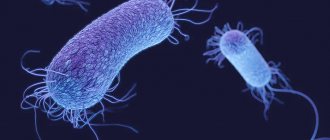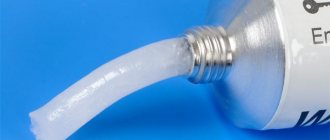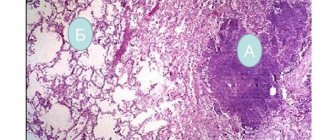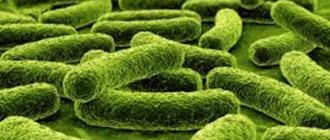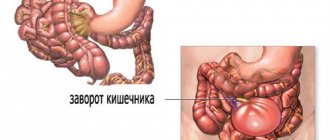Escherichia coli was discovered by the Austrian doctor T. Escherich in 1885 and named in his honor. Based on antigenic and biochemical properties, this microorganism is divided into 2 main types: E. coli and Citrobacter. E. coli are mobile with slightly rounded ends. E. Coli bacteria live in the human intestine as the main components of normal flora. However, there are more than one hundred varieties of pathogenic E. coli. Pathogenic E. coli are divided into four classes: enteropathogenic, enterotoxigenic, enteroinvasive and enterohemorrhagic. Moreover, there are no morphological differences between pathogenic and normal coli bacteria.
The role of Escherichia coli in the intestinal microflora
The number of Escherechia among other representatives of the intestinal microflora should not exceed the norm - 1%. These bacteria play an important role in the gastrointestinal tract. Escherichia coli with normal enzymatic activity is a direct competitor of opportunistic microflora. It, together with bifidobacteria and lactobacilli, prevents its reproduction. E. coli is involved in cholesterol metabolism, fatty acid metabolism, helps the absorption of iron and calcium, promotes the hydrolysis of lactose, produces B vitamins, and produces antibiotic-like substances that inhibit the growth of pathogenic E. coli.
Enzymatic properties
Kp produces numerous saccharolytic enzymes and quickly ferments glucose and other carbohydrates, most often with acid and gas formation. Almost all biotypes of K. constantly ferment mannitol, arabinose, and maltose with the formation of acid; St. 90% of strains - lactose, sorbitol; inconsistently - sucrose, raffinose, rhamnose, xylose, dulcite, salicin; As a rule, adonite and inositol are not fermented. K. p. does not utilize ammonium citrate, sodium malonate, does not grow on a medium with potassium cyanide, does not reduce nitrates to nitrites, does not break down urea, does not liquefy gelatin, most strains form indole and do not emit H2S. K. p. gives a positive reaction with methylrot and a negative Voges-Proskauer reaction (see Voges-Proskauer reaction), does not synthesize the enzymes cytochrome oxidase and phenylalanine deaminase, inconsistently decarboxylates lysine, ornithine and dehydrolyzes arginine.
How much E. coli should there be?
Escherichia coli appears in the intestines from the first days of life. The amount of Escherichia coli with normal enzymatic activity throughout life should remain at the level of 107–108 CFU/g. If deviations from this value are observed during stool analysis, this is a sign of dysbacteriosis. Escherichia coli with reduced enzymatic activity (lacto-negative) is a sign of incipient dysbiosis and an indirect sign of the possible presence of worms or protozoa in the intestines. Exceeding its level of 105 causes infections of the urinary tract, abdominal cavity, intestines and upper respiratory tract. If the number of pathogenic strains of Escherichia coli exceeds, probiotics are used along with basic therapy.
How is Escherichiosis treated?
Children with mild illness are usually treated at home, where they are visited by a pediatrician from the clinic. Patients with moderate to severe disease are hospitalized, as well as usually newborns, since their doctors must monitor them constantly.
Typically, the pediatrician prescribes rehydration therapy for the patient to replenish fluid and electrolyte levels, symptomatic therapy to alleviate his condition, probiotics, enterosorbents, enzymes and sometimes immunoglobulins. Antibiotics are prescribed to children under one year of age and to patients in moderate to severe condition.
As with any intestinal disorder, diet is very important. Infants need to be fed in smaller portions, but more often than usual. Gradually, the volume of each feeding increases, as does the interval between them.
The prognosis is favorable in most cases.
MAKE AN APPOINTMENT PRICES
Pathogenic Escherichia coli
Pathogenic E. coli can cause escherichiosis (infectious diseases of the gastrointestinal tract, urinary tract, sepsis). Infection usually occurs through the fecal-oral route, through dirty hands, contaminated food and water. For example, enteropathogenic Escherichia coli usually develops in the small intestine in children 1 year of age. The development of infection is accompanied by severe diarrhea, abdominal pain, and severe vomiting. Enterotoxigenic Escherichia coli is the cause of acute diarrhea in adults and children. It is also called travelers' diarrhea, because it occurs when traveling to countries of the East and Asia, to the bacteria of which the gastrointestinal tract of Russians is susceptible due to the lack of specific immunity. Enterohemorrhagic Escherichia coli can cause hemorrhagic colitis, as well as a serious disease called hemolytic-uremic syndrome. Enteroinvasive E. coli causes abdominal pain, profuse watery diarrhea mixed with blood, which in all respects is similar to bacterial dysentery.
How can a child become infected with escherichiosis?
E.coli is usually transmitted through food or water, as well as through airborne dust and household contact, including from person to person. There are also known cases of infection from domestic animals. They can survive on the surfaces of objects at room temperature for more than 100 days, in milk for up to a month (and reproduce well in it), in infant formula for up to 3 months. They do not die when dried. At the same time, many strains have developed resistance to many antibiotics. They die only when boiled and when treated with disinfectants.
The seasonal increase in incidence depends on the strain: for EPEC it is winter-spring, for others it is summer.
Based on this, the prevention of colibacillosis comes down to compliance with generally accepted hygiene standards: washing hands and objects that the baby can put in the mouth with soap, washing vegetables and fruits, and, if possible, heat-treating foods.
Escherichia coli. Treatment
You need to understand that the excess growth of pathogenic strains of E. coli occurs against the background of dysbiosis - with a significant decrease in the number of bifidobacteria and lactobacilli, as well as E. coli with normal enzymatic activity. Therefore, if there is a slight excess of lactose-negative Escherichia coli, it is necessary to correct the microflora with bifido- and lactose-containing drugs. According to the “Protocol for the management of patients. Intestinal dysbiosis" (OST 91500.11.0004-2003, section 7.1.8) normal E. coli can be restored when the number of bifidobacteria and lactobacilli is restored to normal. To suppress pathogenic E. coli, doctors often prescribe bacteriophages for a course of no more than 5 days. Bacteriophages selectively destroy pathogenic strains of Escherichia coli. But they do not eliminate dysbiosis itself. An organism with a weakened immune system needs to quickly and reliably restore to normal the number of bifidobacteria, lactobacilli and E. coli with normal enzymatic activity. Bifidobacteria. Lactobacilli and normal E. coli are part of the innate natural immune system. Without these microorganisms, the immune system does not work! Liquid probiotic forms are recognized as the most effective all over the world. Therefore, scientists at the State Scientific Center for Virology and Biotechnology “Vector-BiAlgam” have developed a special probiotic complex that allows you to restore the biofilm of beneficial bacteria on the mucous membranes and increase immunity. Bifidum – a liquid concentrate of bifidobacteria – is a unique preparation. Firstly, a consortium of 3 strains of living active bifidobacteria with a titer of 1,000,000,000,000 = 10 in 12 (trillion) allows you to quickly, effectively, and safely restore the number of beneficial microorganisms and thereby prevent the development of dysbiosis. Secondly, probiotic bacteria are strong antagonists, so they will help the bacteriophage overcome pathogenic E. coli. Thirdly, Bifidum is able not only to fight pathogenic types of E. coli, but also to support typical E. coli, which is needed for the production of vitamin B12 - cyanocobolamin for hematopoiesis. The drug "Trilact" is a consortium of three strains of lactobacilli, which are also necessary to create a powerful biofilm. Trilact regulates the functioning of the immune system and prevents the occurrence of dysbacteriosis during the period of administration and after antibacterial therapy.
Literature
- Florian Hitzenbichler, Michaela Simon, Thomas Holzmann, Michael Iberer, Markus Zimmermann, et. al.. (2018). Antibiotic resistance in E. coli isolates from patients with urinary tract infections presenting to the emergency department. Infection
.
46 , 325-331; - Antibiotics and antibiotic resistance: from antiquity to the present day;
- Model organisms: lambda phage;
- 12 methods in pictures: genetic engineering. Part I, historical;
- Molecular biology;
- At the origins of the genetic code: soul mates;
- Biotechnology. Genetic Engineering;
- Anna Kaznadzey, Pavel Shelyakin, Evgeniya Belousova, Aleksandra Eremina, Uliana Shvyreva, et. al.. (2018). The genes of the sulphoquinovose catabolism in Escherichia coli are also associated with a previously unknown pathway of lactose degradation. Sci Rep
.
8 ; - CRISPR systems: immunization of prokaryotes.
Prevention of intestinal infection
In order to prevent the development of intestinal infection, parents must adhere to the following preventive rules:
- From a very early age, develop primary personal hygiene skills in your child.
- Carefully monitor the cleanliness of the child’s hands and ensure the cleanliness of the objects surrounding the baby.
- Drink only clean water.
- Carefully process fruits and vegetables before giving them to your child.
- Regularly wet clean your home with disinfectants.
If your baby does develop an intestinal infection, you should immediately seek medical help from a specialist. Doctors at the SM-Doctor clinic for children and adolescents will help you quickly identify the disease and prescribe the necessary treatment.
Antigens
Escherichia coli contains O-, K- and H-antigens. O (somatic) antigens in K. p., Shigella and Salmonella have similar chemical properties. structure and are associated with lipopolysaccharide (LPS) of the cell wall (see Lipopolysaccharides). Immunohim, the specificity of the O-antigen is determined by the composition of hexasaccharides in the repeating units of the terminal section of the polysaccharide chain, the other end of which is connected through 2-keto-3-deoxyoctonate (KDO) to lipid A (I). Thus, the structure of E. coli 0111:B4 LPS is presented as follows:
Designations: Col - colitosis, Gl - glucose, Gal - galactose, N-AcGl - N-acetylglucosamine, Hep - heptose, x - unidentified component.
The amount of sugars in the same terminal link, as well as the number of determinant links, varies among different Escherichia serogroups. The specificity of O-antigens K. p. is usually determined in the agglutination reaction (see) with O- or OB-agglutinating coli sera on a glass slide, less often by other methods.
K-antigens denote surface antigens that are associated with the capsule and with LPS K. p. They are divided into A-, B- and L-antigens, which differ from each other in sensitivity to high temperature and chemicals. agents. The highest resistance to heat (up to 100° for 2.5 hours), alcohol and 1 N. HCl solution has the A-antigen, the least stable is the L-antigen. In most K. items, K-antigens are acidic polysaccharides containing uronic acids. Some K antigens (K 88) contain only protein. K. items having K-antigens are not agglutinated by homologous O-coli serum. This feature is inherent in living cultures and is lost after they are boiled or autoclaved. The presence of K-antigens is also established in the adsorption reaction of agglutinins and in immunoelectrophoretic studies (see Immunoelectrophoresis).
N-flagellar, or flagellar, antigens are inherent in actively motile strains. They are associated with the flagellin protein and determine the typical immunochemical specificity of K. p. H-antigens are thermolabile. They are completely destroyed when boiled for 2.5 hours.
In K. the item is described approx. 170 O-antigens, 97 K-antigens and 50 H-antigens. Strains of K. p., equipped with cilia, contain protein ciliated antigens. They are detected in the hemagglutination reaction (see).
St. 123 O-serological groups of Escherichia are connected to each other by unilateral or bilateral antigenic bonds. More than 56 serogroups have antigenic connections with Shigella and 42 serogroups with other representatives of the Enterobacteriaceae family.
K. items are designated according to antigenic formulas: the number of the O-antigen is placed in the first place, the number of the K-antigen is placed in the second place, and the number of the H-antigen is placed in the third place. The type of K antigen is indicated in parentheses. For example, K(A), K(B) or K(L). The numbers of O-, K- and H-antigens are separated by colons. According to antigenic formulas, the studied strain belongs to a certain serol group [for example, E. coli 026:K60 (B6)] and serol type [for example, E. coli 026:K60 (B6):H2]. Differences in the receptors (factor composition) of O-antigens are indicated by small letters. alphabet. For example, serogroup 0111:K58 (B4) is divided into 0111a,b:K58(B4) and 0111a,c:K58(B4).
Plasmids
Escherichia coli may contain various plasmids (see): prophage, F (fertility factor), Col (colicinogenic factor), R (resistance factor), K88 (antigenic factor), Ent (enterotoxigenic factor), etc. Prophages can cause changes in individual signs of K. p., for example. O-antigen (see Lysogeny). F-plasmids determine sexual polarity and cause the formation of sex cilia (sex-pili). Col plasmids control the formation of colicins, which inhibit the growth of phylogenetically related bacteria. R-plasmids are responsible for K. resistance to antibiotics. Plasmid K88 controls the synthesis of the antigen of the same name and threads that determine the adhesive properties of enteropathogenic and enterotoxigenic K. items; Plasmids can be of two types. One of them determines the synthesis of thermolabile, the other - thermolabile and thermostable enterotoxin.
Symptoms of intestinal infection
The symptoms of infectious pathology depend on the type of pathogen that has entered the child’s body and the presence of associated disorders. The most characteristic manifestations are:
- feverish condition;
- headache;
- muscle aches, weakness;
- pain in the abdominal area;
- refusal to eat food;
- nausea;
- vomit;
- diarrhea (possible presence of stool mixed with mucus).
If the child is not provided with timely assistance, the disease takes a severe course. Therefore, the main manifestations of the disease may include:
- a sharp deficiency of fluid in the body (dry skin and mucous membranes, weight loss, practically no urine);
- decreased pressure in the arteries;
- confusion;
- convulsions.
In order to prevent the development of complications, the child must be brought for examination to a specialist even when the first symptoms of an intestinal infection appear - refusal to eat, drowsiness, nausea and vomiting.
